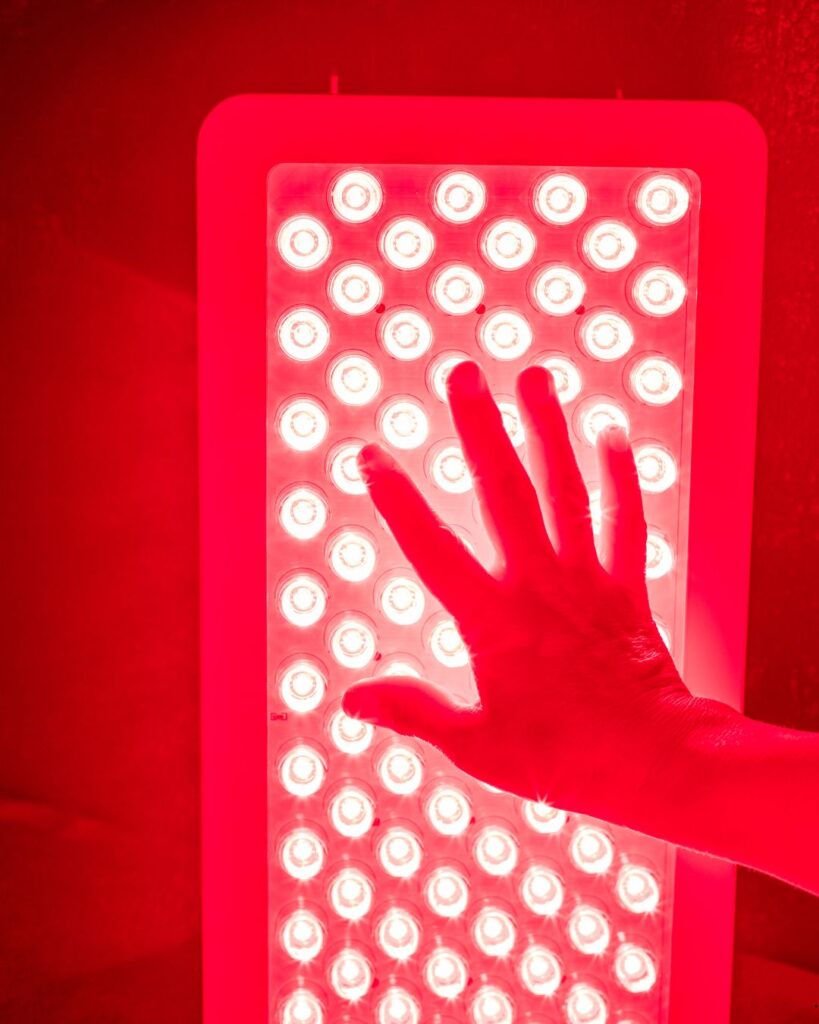Disclaimer: Global Health does not diagnose nor claim to cure cancer. Our services aim to provide science-based, holistic support to complement medical care and enhance well-being during a cancer journey.
A Holistic View: What Is Red Light Therapy?
Red light therapy (RLT), also known as low-level light therapy (LLLT) or photobiomodulation (PBM), uses specific wavelengths of red or near-infrared (NIR) light to stimulate cellular processes. It does not use the harmful ultraviolet (UV) radiation that can damage DNA. Instead, red/NIR light is absorbed by cellular components (notably mitochondria), which can lead to increased cellular energy (ATP), reduced inflammation, enhanced tissue repair, and improved circulation.
In cancer care, RLT is being investigated and used only as a supportive therapy. It is not a substitute for conventional treatments like surgery, chemotherapy, radiation, or immunotherapy. It may help with side effects, quality of life, healing, and resilience when used appropriately and under professional guidance.
What the Science Says: Evidence & Current Research
Here are key findings from clinical and preclinical (animal or cell) studies:
| Outcome | What Research Shows |
| Oral mucositis (mouth sores from chemo/radiation) | RLT has been shown to reduce severity, pain, and duration of oral mucositis in cancer patients. MD Anderson notes its use for oral mucositis and inflammation. MD Anderson Cance |
| Pain and inflammation | Studies suggest RLT can help reduce treatment-related pain, lower inflammation, enhance blood flow, and promote healing of damaged tissues. MD Anderson Cancer Center+2beatcancer.eu+2 |
| Skin healing after radiation | Some clinical reports are positive for acceleration of skin repair (e.g. radiation burns or dermatitis), with improved healing and less discomfort. beatcancer.eu+2MD Anderson Cancer Center+2 |
| Cancer-related fatigue | Systematic reviews show light therapy (broadly defined) may modestly reduce cancer-related fatigue. jpsmjournal.com |
| Safety in cancer patients | There is currently no strong evidence that red light therapy causes cancer or increases cancer risk when used properly. However, there are theoretical concerns, especially if used directly over an active tumour, due to possible stimulation of blood vessel growth (angiogenesis) or metabolic activity. Red Light Factory+2MD Anderson Cancer Center+2 |
Mechanisms of Action: How Red Light Therapy Might Help
Some of the biological processes by which RLT may support healing and resilience in cancer patients include:
- Stimulation of mitochondrial activity → enhanced ATP production, which can boost cell repair and function.
- Reduction of oxidative stress and inflammation.
- Increased microcirculation and supply of oxygen and nutrients to tissues.
- Improved collagen production, which supports skin integrity and wound healing.
- Neuromodulatory effects that may reduce pain and improve mood.
What Red Light Therapy Does Not Do
To avoid misunderstandings, here are things RLT is not proven to do:
- It is not a stand-alone treatment to shrink tumours (outside of photodynamic therapy where a photosensitizing agent is used). Biology Insights+1
- It does not replace conventional medical treatments.
- The optimal dosage (wavelength, power density, duration, frequency) is still under research. Protocols vary, and what works in one study or patient may not translate directly to another.
How Global Health Incorporates Red Light Therapy Safely and Effectively
At Global Health, we believe in integrating red light therapy as part of a comprehensive, science-based supportive care plan. Our approach includes:
- Personalised assessment to understand each individual’s cancer type, treatment plan, skin status, photosensitivity, and overall health.
- Evidence-informed protocols that use wavelengths and intensities shown in studies to be safe and potentially beneficial.
- Use of RLT to target treatment side effects: mucositis, skin damage, pain, inflammation, fatigue.
- Collaboration with the medical team to ensure coordination with surgery, chemo, radiation, and other treatments.
- Monitoring of response, side effects, and ongoing research to adjust protocols.
Why Choose Global Health for Red Light Therapy Support
- We focus on you: your story, your treatment, your well-being.
- Therapies are evidence-based, compassionate, and designed to enhance strength, resilience, and quality of life.
- Our practitioners are trained in integrative modalities, and we use medically appropriate devices.
- We emphasise safety: ensuring red light therapy does not interfere with standard cancer care, avoiding treatment over active tumour masses unless under specialist supervision, and avoiding use with photosensitising conditions or medications.
What to Know Before Trying Red Light Therapy
If you or a loved one are considering red light therapy, here are essential things to discuss with your healthcare provider:
- Are there any contraindications, such as photosensitive conditions or medications?
- Is there risk in using RLT over or near your tumour?
- What wavelength, device type, session duration, and frequency are appropriate given your treatment, skin type, and overall health?
- How will we monitor for improvements and any potential adverse effects?
Red light therapy is a promising complementary tool in cancer care. Scientific studies support its use for improving skin healing, reducing inflammation, relieving pain, managing oral mucositis, and easing fatigue. However, it remains an adjunct, not a replacement, for conventional cancer treatments. When applied properly and under medical supervision, it can help clients feel stronger, recover faster, and support a more resilient mind-body during their journey.

